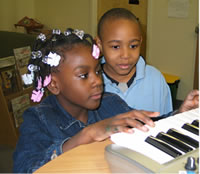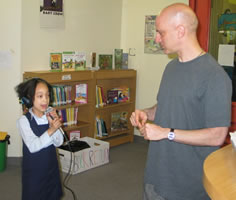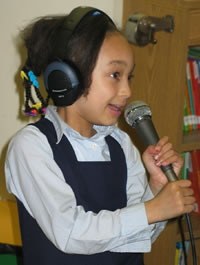Da
Hiphop Raskalz
this is an in depth info page: for the CD, click here
Special gift tune! We're
Famous (Just Like Mary J Blige).
They wrote this because they were invited to perform at
Great Performers at Lincoln Center (a trune story).
This is a project and CD (released Jan 0)7 featuring
music by 5-10 year olds in East Harlem and my neices
from near Boston, Isabella and Michelle.
Each group of four children name their own band, and the
name of the whole project together is Da Hiphop
Raskalz.
T
Rex Chelea & The Mighty Lions
I
Want Candy Muffletoes
Ghosty
Isabella (my niece!)
Do
the Lollipop Sweetness
1,2,3,Go
911 Rock N Roll Coyotes
What's
My Name? Boys & Girls Club Of The Night
Chickenwing
Looneytunes
I
Don't Want You No More Tuff Kids
Feel
Tha Beat The School Rock Band
Schooldogs
Rule The Halls Muffletoes
Xtreme
Team Funkydelic Mix
Woke Up Los Nonameos
Jumpin'
Abc Group
Happy
Go Lucky Day Michelle (another niece!)
Barney
Mac Hiphop Skyhigh
Listen
to the Children on the Radio Franchize
Children
The kids not only write the lyrics and sing and rap,
but play all the instruments and program the drums!
There are a very small number of commercial loops (only
a few) but they choose them too! I coach them and mix:
details are below.
After they make up parts and words they name their
bands. Their head teachers Sharyn Laedlein and Diane
Casado are working with us at the Amber Charter Grade
School at East 106th St.
A cool new article
! Kids in Montreal do their own Raskalz -inspired work,
known as the Modern
Music Project!
  
Daejanay and Sterling (both 6 years old) improvising on
keyboard
Brooklyn (age 6) being coached by Dave
Brooklyn rapping
photos by Sarah Greene
an article
and NPR radio show on Da HipHop Raskalz
Photos
by Joel Rose of NPR of the recording session for
Franchize Children.
Cool reviews from
the Montreal
Mirror
Getupoffathatthing
WFMU
Indieville
notes on recordings
sorry some are incomplete: the sessions can be pretty
chaotic
Boys & Girls Club of the Night
March 20, 2004
Brooklyn Murry 6, Sterling Barnes 7, Seandell Forbes 6,
Daejanay Reeves 7
ABC Group, April 15, 2004
Dorchel Haqq 6, Karisma Hunt 6, Tia West 6, Juan A.
Valdez 7
Tuff Kidz, May 6, 2004
Paige Seymoure 8, Devin Myers 8, Ziana Francois 8
Xtreme Team Funkydelics, February 10,
2005
Taylor Jenkins Thompson 9, Devin Myers 9, Kevin Nunez 9,
Azalee Grace Moore 6
The School Rock Band March 29, 2005
Quintay Toliver 8. Judizia Biron 5, Rebecca Miranda 10,
Dylan Clark 9
The Looneytunes
Taylor Jenkins-Thompson 9, Kelton Brown 9, Darnell
Justice Harris 9, Taasheim Dum 9
Los Nonameos, March, 2005
Juan A. Valdez and others: session disorganized
Muffletoes, October 12, 2005
Divyne Harris 5, Devon Francois 5, Kimberly Hall 7,
Sienna Thomas 8
Isabella and Michelle Azaroff, December
26, 2005
Watertown, MA
911 Rock n' Roll Coyotes, March 28, 2006
Jessica Benicio 7, Ciara Linnen 6, Darion Harris 7,
Xzeyvion Ayree 6
Hiphop Skyhigh April 10, 2006
Xavier Dixon 6, Zhane Devaux 6, Jessica Benicio 7,
Heaven Rembart 5
Chelsea & the Mighty Lions April 25,
2006
Abdoulaye Konate 8, Tamesha Brown 8, Vernon Mitchell 6,
Beyonce Miller 6
Sweetness April 28, 2006
Dorchell Haqq 8, Daichell Griffin 8, Ryan Summers 8,
Naya Motta 8
Franchize Children August 1, 2006
Savion Daniel 9, Ciara Linnen 6, Jaliah Cobbs 10, Imani
Cowings 8
cover art design (not shown)
MLRA Design Group
Maia Wheaton 6
Azaelea Moore 7
Lianna Bowser 6
Rebecca Miranda 10
with assistance from adult Jennifer Kotter
How we made Da Hiphop Raskalz and advice on how to try
it
First, I suggest finding out what music
the kids listen to. I had thought that kids in East
Harlem would like what the little Dominican kids listen
to in New York in West Harlem, but I was wrong…
otherwise I would have attempted to help them make a
different kind of style. For the Tangerine
Awkestra a few years ago, an analogous project,
the kids were mostly home schooled from Fort Greene and
Brooklyn, and were familiar with jazz and rock; the
music they made and the instruments we selected were
very different.
Since the kids at Amber Charter School
almost all said they listened to hip-hop, we (Elana
Langer and me) experimented a bit with a portable
studio. The goals were
- instruments the kids can learn to play quickly
- the sounds should be ones they are used to and
like
- the setup should be fast to set up and break down
and be easily transported
- make anything the kids operate nearly
non-breakable
For the last point, I quickly learned
to not use more than 4 kids at a time. Otherwis, they
start wrestling, which can damage the equipment, and
lose interest in the music.
I thought of using old style drum
machines and a turntable, as the early instruments of
hip-hop, but they were even hard for me to manipulate.
The setup that worked best can be fit in one shopping
bag and is:
- a laptop computer: I use a Mac G4
- a USB MIDI keyboard: I use one from MOTU (Oxygen
8) that costs about $100
- a cheap microphone: I use a condenser type that
costs about $60 that has been dropped without damage
many times. Another virtue is the cheap condensers
distort, lending an authentic and warm sound to the
vocals. You CANNOT tell kids to hold mics a uniform
distance away from their mouths: they will just
imitate what they have seen with people mouthing
lyrics on videos – but these mics seem to work
anyway. Sometimes its good to have one kid hold the
mic for another.
- an A-to-D converter for the mic: I have been using
one by MOTU, which is only about $100
- a couple of small powered computer speakers that
cost about $20
- an assortment of easy-to-play real instruments: a
thumb piano, slide whistles, plastic toy guitars,
and several drums including a conga
- an extension cord
For software, I initially preferred
Digital Performer “slaving” Reason. Performer is superb
for mixing, and Reason has a fantastic drum machine
module that you can teach yourself and kids quickly.
Unfortunately, the combination was unstable and for
“reasons” unknown would sometimes crash my laptop. You
simply can’t afford the downtime with little kids, who
will run off somewhere as soon as they become impatient.
I then used GarageBand, the Apple
program, still slaving Reason. GarageBand is more stable
on my laptop and in some ways good for this sort of
project but has major problems. The first is that there
is no drum machine module – I would steer clear of the
GarageBand premade drum loops, as one of the most
interesting things with Da Hiphop Raskalz is the kid’s
decisions on making drum grooves on the Reason drum
module, coming up with beautiful and unconventional
idiosyncratic music.
Another problem with Garage Band is how
the software manages the recorded files – if you
accidentally record over a good track, you will never
find it again: infuriatingly, the software makes the
files invisible. Also, sometimes GarageBand simply stops
recording, and we occasionally lose our best takes: keep
your eye on the tracks!
Another infuriating feature is that to
put the files (which after all are already in AIFF,
which any program can read) in a form that can be
accessed, they have to be downloaded TRACK BY TRACK to
ITunes. This is a big waste of time, and can add hours
of unproductive labor. Finally, editing the tracks
requires many cut and paste steps, in contrast to
Digital Performer, which is fast and intuitive. Since
these bad programming choices are so simple to fix, I
wonder what Apple software engineers are thinking… they
must have some evil bureaucrats at the company making
Microsoft-like choices designed to make sure their
program is incompatible with others.
BUT on the positive side, GarageBand
(and Reason too) has great soft synth modules, and
digital processing that you can use on voices – for
instance the squeaky vocals on Ghosty was done using
GarageBand’s “Helium” on one of Isabella’s vocal tracks.
Kids enjoy hearing and choosing from these options.
Here is what worked best for me with a
recording session.
Tell the kids that first we will come up with a drum
groove. I say the easiest drum beat in the world is a
solo bass drum – that’s the one you play with a foot
pedal like this – on every beat. One, 2, 3, 4 – then I
put a bass drum sound on each beat in the Reason drum
machine. I tell them to choose which bass drum sound
they want by cycling through the different sounds, and
they reach a consensus. Then ask them to sing their own
rhythm for the bass drum – it doesn’t have to be on
every beat. If they come up with one, I will change the
programming to match what they are making up.
Then tell them the snare drum – which you play up here
like this and sounds like “thwack” – is most
traditionally played on the 2 and 4 LIKE THIS. Ask them
to choose their favorite snare drum sammple – this can
take a few minutes – and then sing or tap on the desk
what rhythm you would like.
Now ask how fast it should be – you can change the tempo
until they all like it. Then add other drums like hi
hats, etc., in the same way: have them choose which
sounds they like, and where the beats should be. By now
the kids are dancing around and some of them have some
very firm ideas of what the drums should sound like.
Now one of the most fun parts: who can make human beat
box sounds? Record them on a GarageBand vocal track.
Tell them the next traditional element to add is the
bass, which they can imitate with the synthesizer. Who
can play the piano? They will all say they can. Show
them how to hold their hands and press their fingers on
the piano keyboards, and have them choose a bass sample.
Then they can improvise while you record the tracks into
GarageBand. I tell them to listen to the music for a
while before they play so they will be in time: also if
they find something they like, play it a few times! It
is good to have alternate takes of a good line when it
is time to mix.
Then tell them that there are other sounds we can use
like strings, cellos, guitars, organs, and let them
which instrument modules they like in either Reason or
Garage Band. I tend to use Garage Band because it is
simpler to control for this use, as you just hit record
– however the sound choices in Reason are really nice as
well.
At this point the music is getting pretty dense
(remember to save the files), and I tell them to take a
break, meet at the table and come up with a name for
their band. This can take a while… both here and with
the lyrics, try to figure out when they are simply
copying a song or band name they know from TV or the
radio. Actually, all composers write songs based on
other songs (maybe Harry Partch was an exception), but
we all know the ways of the world well enough to keep
changing and disguising it until it sounds original (if
you don’t believe my claim that all songwriters copy
models of other songs, I want a better explanation of
why almost all pop songs use only about 3 or 4
structures, e.g., 16 bar verse, chorus, verse, chorus, 8
bar bridge, verse chorus). The kids don’t always
understand the theory of making the audience think their
work is “original” and will just use a favorite phrase
as they have heard it – anyway, it is more challenging,
fun and funnier for the kids to transform/make up their
own ideas.
After the band name battles, it’s time for lyrics. If
they can’t think of anything, mmake suggestions: TV
shows, horror movies, school lessons, jump rope, on and
on. Sometimes the name of the band is enough to trigger
lyrics. Often they will write lyrics down, but
improvising singly or in groups keeps everyone
interested, and generally is the best approach. Then
once they improvise, if something is particularly
outstanding, suggest they expand on it. After there is
plenty of material, it will be up to you to mix it
Now show them how to play those easy instruments like
slide whistles and record them – tell them to LISTEN to
the tracks they already recorded first before playing.
If there is still time – the above steps usually take
about 2 hours – they can help choose the best parts and
start mixing with you. They often get too excited at
this step…
Not much advice for mixing – mostly
figure out what to throw out! Many hours of several
tracks will be distilled to a 120 second song.
I hope the ease and fun of this project
will encourage you to try it. Send me any cool mp3s to
hear – maybe we can release some of them to or put on
the website – and if you find new means or variations on
this approach, I’ll post them on this website.
-Art for all ages!
Your pal Dave Soldier
August 10, 2006
|